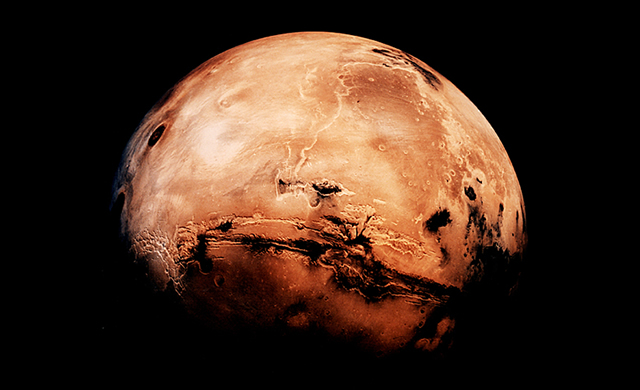
Marte – Mars – Credit: NASA
Rilevamento del DNA nello spazio – I ricercatori, in un ulteriore passo verso l’analisi di Marte alla ricerca di segni di vita, trovano che un chip di sequenziamento genico può sopravvivere alle radiazioni spaziali. Se c’è vita su Marte, non è troppo inverosimile credere che tali specie di marziani potrebbero condividere radici genetiche con la vita sulla Terra. Più di 3,5 miliardi di anni fa, uno sciame di meteore rimbalzò in tutto il sistema solare, scambiando materiale tra i due pianeti, allora agli esordi. Questo gioco galattico di pingpong può aver lasciato pezzi di Terra su Marte, e viceversa, creando una discendenza genetica comune tra i due pianeti.
Questo è una teoria che sembra convincere Christopher Carr, un ricercatore nel Dipartimento di Terra, Atmosfera e Scienze Planetarie del Massachusetts Institute of Technology, il famoso MIT. Lavorando con Gary Ruvkun presso il Massachusetts General Hospital (MGH) e Maria Zuber, dell’EA Griswold, Professore di Geofisica e vice presidente per la ricerca del MIT, Carr sta mettendo a punto la costruzione di un sequenziatore di DNA che spera un giorno sarà inviato su Marte, dove sarà in grado di analizzare campioni di terreno e di ghiaccio per rilevare tracce di DNA e di altro materiale genetico. Ora, in un passo verso questo obiettivo, Carr e i colleghi del MIT, di Harvard e MGH, hanno esposto il cuore del loro strumento: un microchip per il sequenziamento del DNA, sottoposto a dosi di radiazioni simili a quelle che potrebbero essere attese durante la ricerca effettuata tramite robot su Marte. Dopo l’esposizione a tali radiazioni, compresi protoni e ioni pesanti di ossigeno e ferro, il microchip ha analizzato un ceppo di E. coli come prova, individuando con successo la sua sequenza genetica. Carr dice che i risultati del gruppo mostrano che il microchip può sopravvivere fino a due anni nello spazio, abbastanza a lungo per raggiungere Marte e raccogliere dati per un anno e mezzo. “Nel corso del tempo su Marte, le prestazioni di un chip potrebbero degradare, riducendo la nostra capacità di ottenere i dati della sequenza. Il chip potrebbe avere un tasso di errore più elevato, o potrebbe non funzionare affatto “, dice Carr. “ma non abbiamo rilevato alcuno di questi problemi [nei nostri test]. … Una volta che questo chip sarà stato in missione per due anni su Marte, sarà ancora in grado di rilevare le sequenze di DNA. “I ricercatori hanno segnalato i loro risultati in un articolo pubblicato sulla rivista Astrobiology.
Detecting DNA in space – Researchers, in a step toward analyzing Mars for signs of life, find that gene-sequencing chip can survive space radiation. If there is life on Mars, it’s not too farfetched to believe that such Martian species may share genetic roots with life on Earth. More than 3.5 billion years ago, a blitz of meteors ricocheted around the solar system, passing material between the two fledgling planets. This galactic game of pingpong may have left bits of Earth on Mars, and vice versa, creating a shared genetic ancestry between the two planets.
Such a theory holds great appeal for Christopher Carr, a research scientist in MIT’s Department of Earth, Atmospheric and Planetary Sciences. Working with Gary Ruvkun at Massachusetts General Hospital (MGH) and Maria Zuber, the E.A. Griswold Professor of Geophysics and MIT’s vice president for research, Carr is building a DNA sequencer that he hopes will one day be sent to Mars, where it can analyze soil and ice samples for traces of DNA and other genetic material. Now in a step toward that goal, Carr and colleagues at MIT, Harvard University and MGH have exposed the heart of their tool — a DNA-sequencing microchip — to radiation doses similar to those that might be expected during a robotic expedition to Mars. After exposure to such radiation — including protons and heavy ions of oxygen and iron — the microchip analyzed a test strain of E. coli, successfully identifying its genetic sequence. Carr says the group’s results show the microchip can survive up to two years in space — long enough to reach Mars and gather data there for a year and a half. “Over time on Mars, a chip’s performance could degrade, reducing our ability to get sequence data. The chip might have a higher error rate, or could fail to function at all,” Carr says. “We did not see any of these issues [in our tests]. … Once this chip has been through two years of a Mars mission, it still will be able to sequence.” The researchers reported their results in a paper published in the journal Astrobiology.
Source/Continue reading → web.mit.edu






















Pingback: Ancora sul DNA: E se il famoso segnale “Wow!” fosse all’interno del codice genetico terrestre? – The “Wow! signal” of the terrestrial genetic code | DENEB Official ©